The standard golf ball diameter is mandated by the United States Golf Association (USGA) and the Royal and Ancient Golf Club of St Andrews. The diameter of a golf ball is 1.68 inches (4.2672 cm and 42.67 mm). No modern golf balls can exceed this limit. In doing so, that particular golf ball will become illegal.
However, golf ball diameter is not the only defining factor for the legality of golf balls. The governing bodies have pre-determined a set list of golf ball dimensions. Golf ball manufacturers are bound to keep within the standard golf ball size.
- Are All Golf Balls Same in Size?
- Golf Ball Over the Centuries
- Golf Ball Diameter
- Golf Ball Weight
- Circumference of a Golf Ball
- Golf Ball Radius
- Golf Ball Volume
- Difference Between Two Piece, Three Piece, and Multi-layer Golf Balls and Their Diameter
- Difference Between Firmer and Softer Golf Balls and Their Impact on Diameter
- How a Golf Ball Will Affect the Game if Diameter is Changed
- People Also Ask
- Final Words
Are All Golf Balls Same in Size?
In terms of golf ball dimensions, all golf balls are the same size.
In 1990, the United States Golf Association announced that a standard golf ball should not exceed 1.68 inches in diameter and 45.93 grams (1.62 ounces) in weight. The minimum diameter has to be 1.65 inches.

A golf ball should perform within specific velocity, flight, distance, and dimple symmetry. Nevertheless, golf ball diameter and weight are not the only stipulations. Factors like circumference, radius, and volume were also mandated.
Let’s briefly discuss all of these golf ball dimensions and their evolution.
Golf Ball Over the Centuries
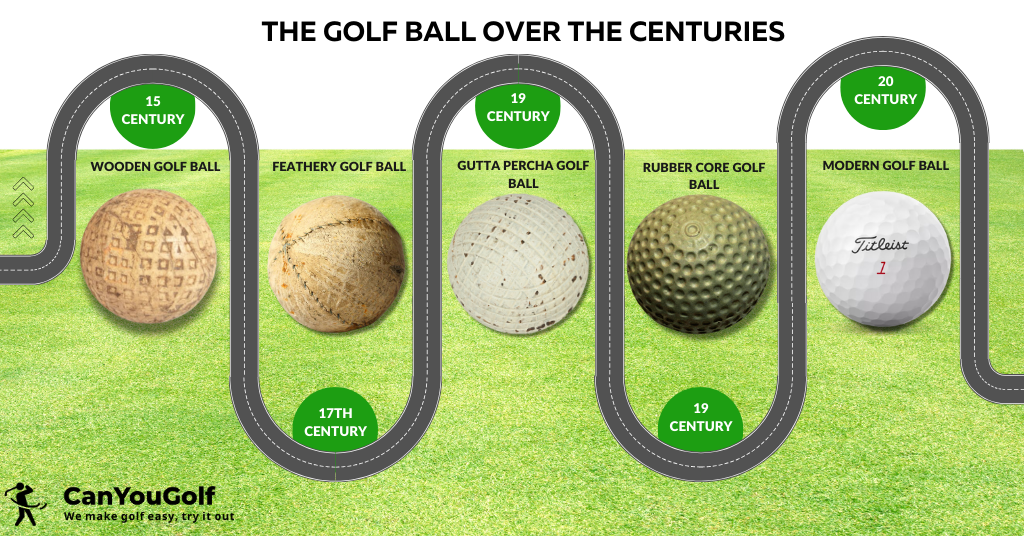

Golf Ball Diameter
It would not be wrong to say that golf balls have gone through the most upgrades.
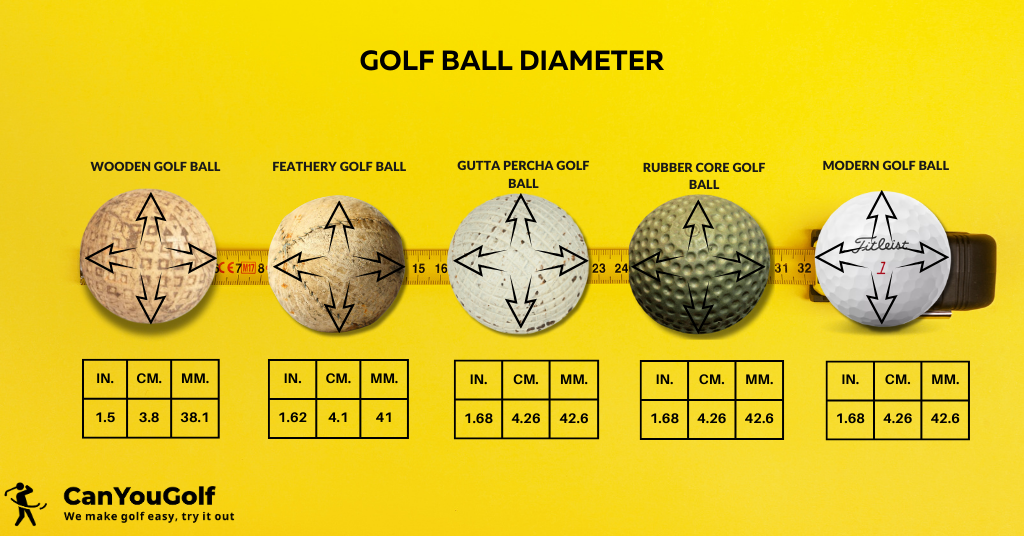

Early Wooden Golf Balls
In the 15th century, golf balls were made with hardwood. Primarily, the material used was either beech wood or boxwood. These were the smallest golf balls in diameter. They were 1.50 inches (3.81 cm and 38.1 mm) in diameter.
The lack of proper machinery led to slight variations in the production. It was a smaller golf ball and caused a deviation in the flight and lowered distance.
Feathery Golf Balls
Later in the 17th century, feathery (featherie ball) was introduced. Wooden balls were discarded, and a leather covering (like a pouch) was made. Golf ball manufacturers used to stuff feathers in the pouch and stitch it.
These golf balls were more durable and their diameter was approximately 1.62 inches (4.1 cm or 41 mm). However, these golf balls also lacked uniformity.
Gutta Percha Golf Balls
In the mid-19th century, feathery golf balls were replaced with the Gutta Percha golf balls. These golf balls were made with the sap of the Gutta tree. This tree was found in Southeast Asia. This was the best development so far.
Gutta Percha golf ball diameter was 1.68 inches (4.26 cm or 42.67 mm). For its durability and performance, Gutta became the standard golf ball for many decades. Gutta golf balls were the flagbearers of introducing dimples on a golf ball.
Learn more about how dimples were introduced and how many dimples are on a golf ball here.
Rubber Core Golf Balls
In the 20th century, the Haskell golf balls were introduced. These rubber-core wound golf balls outclassed gutta golf balls. These golf balls featured a solid rubber core surrounded by tensioned rubber threads.
Coburn Haskell, founder of the rubber-core balls maintained a golf ball diameter of 1.68 inches (4.26 cm or 42.67 mm). This diameter was proved to perform the best and most consistently.
Modern Golf Balls
In the later half of the 20th century, the USGA ruled that no golf ball should exceed 1.68 inches (4.26 cm or 42.67 mm) in diameter. This rule is still followed in contemporary golf balls.
While the standard diameter persists, advancements in materials (multi-layer golf balls) and aerodynamics have allowed for diverse designs.
Golf Ball Weight
Just like the diameter of the golf ball, the golf ball’s weight also varied across history.
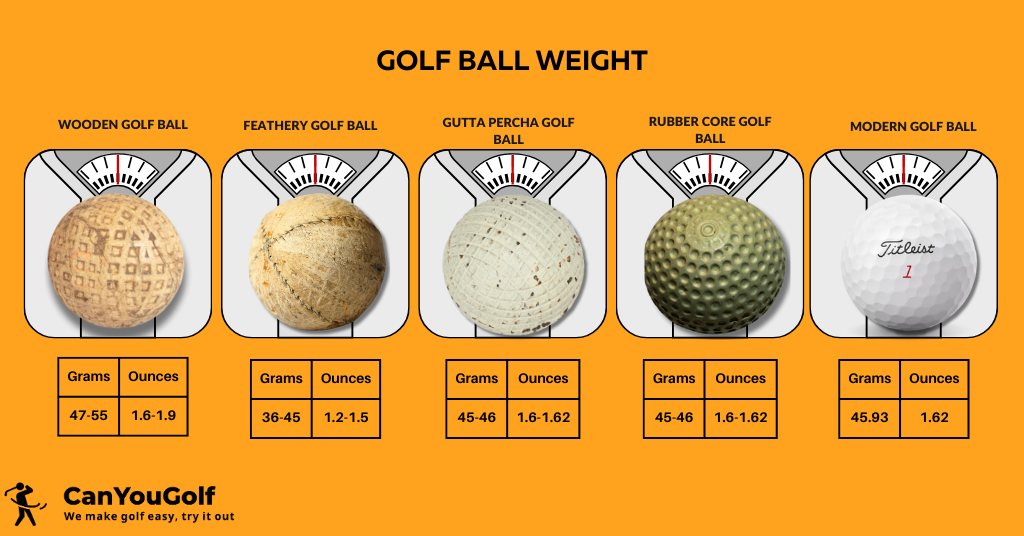

The wooden golf ball was the heaviest. They ranged from 47-57 grams (1.6-1.9 ounces). A few golf balls went above 57 grams. This inconsistency in the golf ball weight distribution resulted in lower distance and performance.
On the contrary feathery golf ball was the lightest. Most of these weighed between 36-45 grams (1.2-1.6 ounces). This resulted in irregular ball flight and distance. The air resistance was also low.
Gutta Percha and Rubber-core golf balls were identical in weight. These golf balls weighed 45-46 grams (1.6-1.62 ounces)
Whereas the modern and standardized USGA golf ball is mandated an upper limit of 45.93 grams (1.62 ounces)
Golf ball weigh remained a critical factor for golfers’ looking for straighter ball flight.
Circumference of a Golf Ball
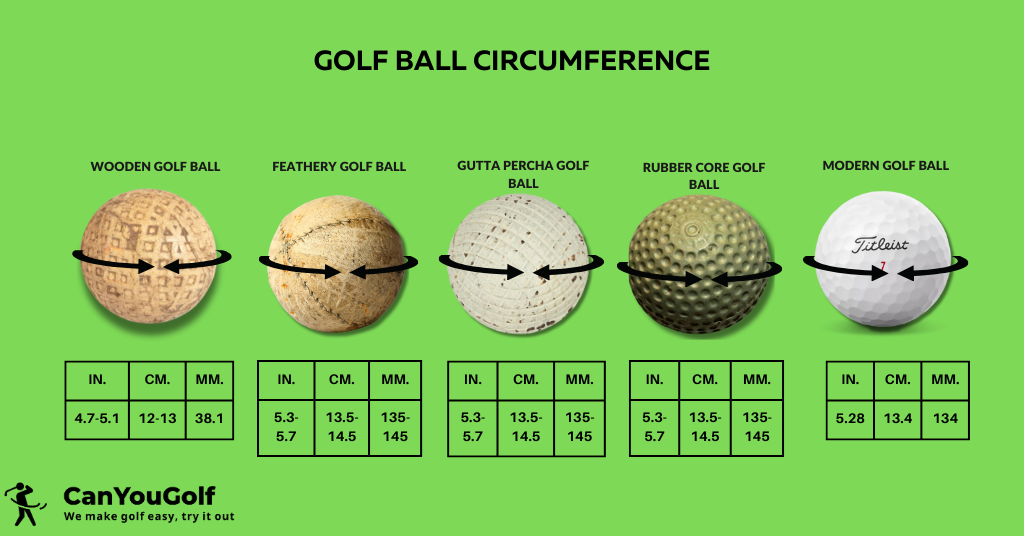

The early wooden’s were the smaller golf balls. They had a circumference ranging between 4.7-5.1 inches (12-13 cm or 120-130 mm).
Feathery golf balls exhibited a more uniform circumference of around 5.3-5.7 inches (13.5-14.5 cm or 135-145 mm). The increased consistency contributed to improved playability and distance.
The Gutta Percha and Rubber-core golf balls were similar in circumference. Their circumference ranged between 5.3-5.7 inches (13.5-14.5 cm or 135 to 145 mm).
In 1932, a standard circumference of 5.28 inches (13.4 cm or 134 mm) was officially set for golf balls, a dimension that remains a cornerstone for the modern and standard golf ball.
As time progressed, golf ball size changed to find uniformity and consistency in performance.
Golf Ball Radius
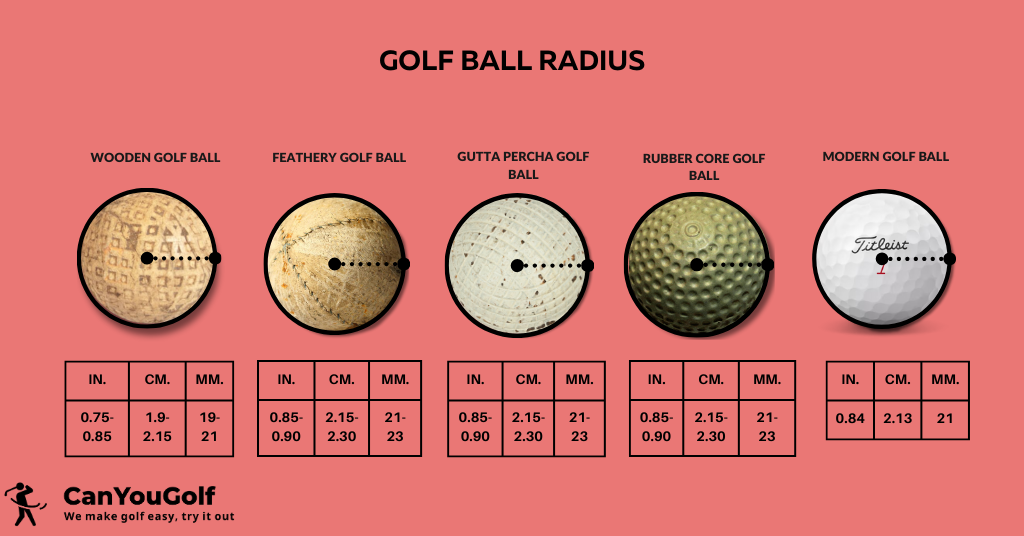

Along with the dynamic changes in golf ball manufacturing, golf ball radius also became an important factor in bringing uniformity in the standard golf ball size.
As discussed above, the wooden golf ball was the smallest. Its radius was approximately 0.75-0.85 inches (1.9-2.15 cm or 19-21 mm). The feathery golf ball has a more consistent radius of around 0.85-0.90 inches (2.15-2.30 cm or 21-23 mm).
The Gutta Percha and rubber-core golf ball have a similar golf ball radius of 0.85-0.90 inches (2.15-2.30 cm or 21-23 mm). The contemporary golf ball radius as per the USGA is set to 0.84 inches (2.13 cm or 21 mm)
Golf Ball Volume


The volume of the wooden golf ball was 1.76-2.57 cubic inches (28.8-42.1 cm3). The feathery golf ball was 2.57-3.05 cubic inches (42.1-49.9 cm3) in volume. The Gutta Percha and Haskell golf balls were also 2.57-3.05 cubic inches (42.1-49.9 cm3).
The latest golf ball volume is 2.48 cubic inches (40.68 cm3).
Difference Between Two Piece, Three Piece, and Multi-layer Golf Balls and Their Diameter
Primarily, there are three types of golf balls. Does the construction cause any alterations in the golf ball diameter? Let’s find out.
New wpDataTable
| Golf Ball | Two Piece | Three Piece | Multi-Layer |
|---|---|---|---|
| Layers | 2 | 3 | 4 or more |
| Core | Solid Rubber | Synthetic Rubber | Solid Core |
| Swing Speed | Slow | Moderate | Fast |
| Player Type | Beginners | Intermediate | Advanced |
| Diameter | 1.68 | 1.68 | 1.68 |
Two-Piece Golf Balls
Two-piece golf balls are characterized by a simple construction comprising a solid rubber core and a cover. Known for their durability and distance, these balls offer a low spin rate, making them ideal for beginners with slower swing speeds.
Their design adheres to the standard golf ball diameter of 1.68 inches.
Three-Piece Golf Balls
Three-piece golf balls feature a complex structure with a solid core (synthetic rubber), an intermediate layer, and an outer cover. This design allows for better control, spin, and feel, catering to a wider range of skill levels. These are ideal for moderate swing speeds.
The golf ball diameter remains standard at 1.68 inches, providing consistency across designs.
Multi-layer Golf Balls
Multi-layer golf balls, often with four or more layers, are designed for advanced players seeking a balance of distance, control, and feel. These balls incorporate various materials and thicknesses in their layers to optimize performance. These are good for faster swing speeds.
Multi-layer golf ball diameter remains consistent at the standard 1.68 inches, ensuring adherence to regulations.
Difference Between Firmer and Softer Golf Balls and Their Impact on Diameter
There is neither a change in the diameter nor the golf ball size based on the feel of the golf ball.
wpDataTable with provided ID not found!Firmer Golf Balls
Firmer golf balls typically have a higher compression rating, indicating greater resistance to deformation upon impact. This results in reduced spin and a firmer feel.
Despite the variation in feel, the golf ball diameter remains consistent at the standard 1.68 inches.
Softer Golf Ball
Softer golf balls are manufactured with lower compression ratings. These compress more upon impact, providing increased spin and a softer feel. While the feel differs from firmer counterparts, the golf ball diameter remains unchanged at the standard 1.68 inches.
Manufacturers optimize these softer balls for enhanced control and feel without altering the regulated size of the golf ball.
Learn more about the Compression Ratings of 30+ golf balls and their properties here.
How a Golf Ball Will Affect the Game if Diameter is Changed
Altering the golf ball’s diameter would significantly impact the game. It will influence the performance and player experience. This modification will lead to changes in distance, accuracy, and overall playability, affecting the dynamics.
People Also Ask
Are There Any Golf Balls Whose Diameter is More Than 1.68 Inches?
No, there are no golf balls with a greater diameter than 1.68 inches. The lowest golf ball diameter was 1.50 inches (early wooden balls). The highest golf ball diameter is 1.68 inches.
What is the Diameter of a Golf Ball?
The diameter of a golf ball refers to the distance across the ball measured through its center, passing from one side to the opposite side. The standard golf ball diameter is 1.68 inches.
Is a Golf Ball 4 cm?
No, a golf ball is 4.2672 cm in diameter. The smallest diameter of a golf ball was 3.81 cm in the early 15th century.
What is the Radius of a Golf Ball?
The radius of a golf ball is the distance from the center of the ball to its outer surface. The radius of a standard golf ball is 0.84 inches (2.13 cm or 21 mm).
What Diameter of a Golf Ball is Allowed in Tournament Play?
A golf ball diameter of 1.68 inches is allowed in tournament play. All other golf ball diameters are illegal as per the USGA and rules.
What is the Diameter of Titilest Pro V1?
The diameter of the Titleist Pro V1 is 1.68 inches.
Are Golf Balls the Same Size?
Yes, all golf balls are the same size. They vary based on construction, cover, core material, and dimple pattern.
Final Words
Golf has progressed through the centuries. Golf ball diameter has a history of evolution, technological innovation, and global perspective. From a 1.50 golf ball diameter to the standard 1.68 inches, a lot has changed.





